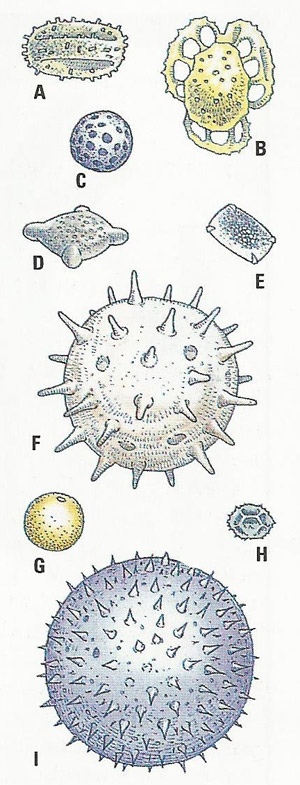pollen

Pollen grains are found in flowers' pollen sacs, which are themselves located in the anthers (part of the stamens). Pollen grains are safe and effective storers of the male gametes (sex cells). They come in all shapes and sizes depending on the species of plant. The selection shows mistletoe (A), venus fly trap (B), spinach (C), honeysuckle (D), touch-me-not (E), cotton (F), rice (G), dandelion (H), and hollyhock (I).
Pollen consists of powder-like spores, usually yellow in color, which give rise to the male gametes in plants.
In angiosperms (flowering plants), pollen grains are produced in the anthers on the stamen, whereas in gymnosperms (cone-bearing plants), they are produced by the male cones.
Pollen has thick resistant walls with a characteristic pattern of spines, plates, or ridges, according to species.
During pollination, the pollen lands on the stigma of a flower, or a female cone, of a compatible plant. It germinates, sending out a long pollen tube down through the style to the ovary. During this process, one of its nuclei divides, give rise to two male nuclei, one of which will fuse with a female sex cell (actually a haploid nucleus in the embryo sac inside the ovule) in fertilization. The other male sex cell fuses with two more of the female nuclei to form a special tissue, the endosperm, whose cells contain three sets of chromosomes (triploid). In many species, this tissue develops into a food store for the embryo in the seed.
Pollen tube
A pollen tube is a tube formed after germination of a pollen grain. The pollen tube carries the male gametes into the ovule (egg). In flowering plants each pollen tube penetrates the tissues of the stigma and style on its way to the ovary. After entering the ovary, each pollen tube grows toward an ovule, passing down a micropyle to the nucellus and finally penetrating the nucellus tissues into the embryo sac where it ruptures at the tip, releasing two male gametes, one of which fuses with the egg nucleus. The second male gamete fuses with the central fusion nucleus; the resulting nucleus, called endosperm, surrounds the developing embryo and provides food for its growth.


